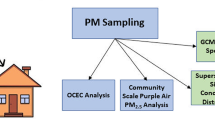Abstract
Throughout August and September, 2003, wildfires burned in close proximity to Missoula, Montana, with smoke emanating from the fires impacting the valley for much of the summer. This presented the perfect opportunity to measure the levels of polychlorinated dibenzodioxins and dibenzofurans (PCDD/F) comprising ambient forest fire smoke particles impacting the Missoula Valley. An air sampler at the Montana Department of Environmental Quality's (DEQ) compliance site in Missoula measured hourly averages of PM10 throughout the fire season. Three collocated PM2.5 cyclones collected 24-h smoke samples using quartz filters and Polyurethane Foam (PUF) sorbent cartridges. From the quartz filters, concentrations of Organic and Elemental Carbon (OC/EC) were measured, while PCDD/F were measured from one set of a filter (particle phase) and PUF (vapor phase) aggregate of samples in an attempt to also investigate the different phases of PCDD/F in forest fire smoke impaired communities.
Hourly PM10 concentrations peaked at 302.9 μg m−3 on August 15. The highest OC concentration (115.6 μg m−3) was measured between August 21–22, and the highest EC concentration of 10.5 μg m−3 was measured August 20–21. Measurable concentrations of PM2.5 associated PCDD/Fs were not detected from a representative aggregate sample, with the exception of small amounts of 1,2,3,4,6,7,8-heptachlorodibenzodioxin and octachlorodibenzodioxin. PM2.5 samples collected during the smoke events were composed of approximately 65% OC. However, the OC fraction of the particles collected in the smoke impaired Missoula valley was not composed of significant amounts of PCDD/F.
Similar content being viewed by others
References
Buckland, S., Dye, E., Leathem, S. and Taucher, J.: 1994, ‘The levels of PCDDs and PCDFs in soil samples collected form conservation areas following brush fires’, Organohalogen Compounds 20, 85–89.
Clement, R. and Tashiro, C.: 1991, ‘Forest Fires as a Source of PCDD and PCDF’, in: Proceedings of the 11th International Symposium on Chlorinated Dioxins and Related Compounds, September 23–27, 1991, Research Triangle Park, NC.
Environment Australia: 2002, ‘Sources of Dioxins and Furans in Australia: Air Emissions (revised edition)’, Canberra, Australia.
Gullett, B. K. and Touati, A.: 2003, ‘PCDD/F emissions from forest fire simulations’, Atmos. Environ. 37, 803–813.
Kim, E.-J., Oh, J.-E. and Chang, Y.-S.: 2001, ‘Does forest fire increase the PCDD/Fs level in soil?’, Organohalogen Compounds 50, 386–389.
Montana DNRC: 2004, ‘Forestry Division Fire & Aviation Bureau Website’, available at http://dnrc.state.mt.us/forestry/dnrcfiresite/FireManagement/Statistics.aspx.
Prange, J. A., Gaus, C., Weber, R., Päpke, O. and Müller, J. F.: 2003, ‘Are forest fires a source of PCDD/Fs in Queensland, Australia?’, Organohalogen Compounds 60, 60–65.
UNEP Chemicals: 1999, ‘Dioxins and Furan Inventories – National and Regional Emissions of PCDD/PCDF’, Geneva, Switzerland.
USEPA: 1994, ‘Method 1613. Tetra – Through Octa – Chlorinated Dioxins And Furans By Isotope Dilution HRGC/HRMS (Revision B)’, EPA/821B94005a.
USEPA: 1999, ‘Compendium Method TO-9A. Compendium of Methods for the Determination of Toxic Organic Compounds in Ambient Air, Second Ed., Determination of Polychlorinated, Polybrominated and Brominated/Chlorinated Dibenzo-p-Dioxins and Dibenzofurans in Ambient Air’, EPA/625/R-96/010b.
USEPA: 2001, ‘Exposure and Human Health Reassessment of 2,3,7,8-tetrachlorodibenzo-p-dioxin (TCDD) and Related Compounds, Part I, Vol. 2: Sources of Dioxin-Like Compounds in the United States’, Draft (external) Final Report, EPA/600/P-00/001Cb.
Van Oostdam, J. and Ward, J.: 1995, ‘Dioxins and Furans in the British Columbia Environment’, BC Environment, Environmental Protection Department, Victoria, British Columbia.
Walsh, P., Brimblecombe, P., Creaser, C. and Olphert, R.: 1994, ‘Biomass burning and polychlorinated dibenzo-p-dioxins and furans in the soil’, Organohalogen Compounds 20, 283–287.
Ward, D. E. and Hardy, C.: 1989, ‘Organic and Elemental Profiles for Smoke from Prescribed Fires’, in: Receptor Models in Air Resources Management: Transactions of an International Specialty Conference of the Air and Waste Management Association’, 1989, Pittsburgh, PA, pp. 299–321.
Author information
Authors and Affiliations
Corresponding author
Rights and permissions
About this article
Cite this article
Ward, T.J., Lincoln, E. Concentrations of PM2.5-associated OC, EC, and PCDD/Fs measured during the 2003 wildfire season in Missoula, Montana. Environ Monit Assess 115, 39–50 (2006). https://doi.org/10.1007/s10661-006-5252-6
Received:
Accepted:
Published:
Issue Date:
DOI: https://doi.org/10.1007/s10661-006-5252-6




